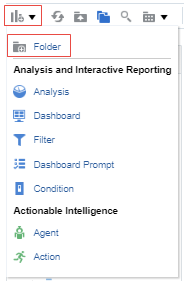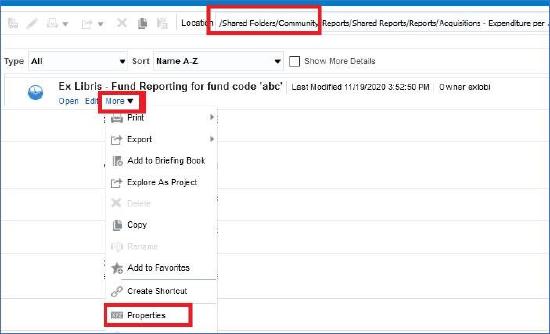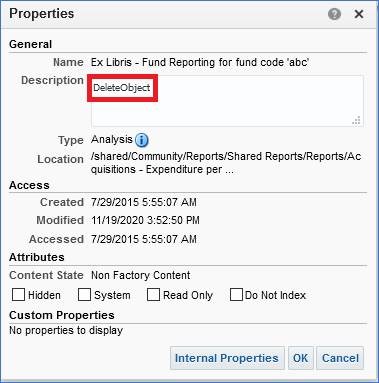Esploro Community Folder Structure
While institutions are able to create folders, reports and other entities in the Community, the overall structure is maintained by Ex Libris with input from the community. This overall structure is described below.
To add a new folder to the Community Folder, select the Community folder from the pane, select the New icon ![]() in the top left corner, and select Folder:
in the top left corner, and select Folder:

Adding a New Folder
The following is an example of the organizational structure and usage methodology for the reports in the community folder. It is currently divided into different subject areas or by who shared them. There are several sub-folders under Shared Folders > Esploro Community > Reports:
.png?revision=1&size=bestfit&width=650&height=462)
Esploro Community > Reports
The following table describes these sub-folders:
| Sub-Folder | Description |
|---|---|
| Ex Libris | A folder for materials provided by Ex Libris teams, such as the Product or Support teams. |
| Other | A folder for miscellaneous reports. |
| Research Assets | A folder for institutions to open sub-folders as desired and share reports, dashboards, etc. for the Research Assets Subject Area. Each institution can contribute their own reports, prefixing the report by the name of their institution. |
| Research Assets Usage | A folder for institutions to open sub-folders as desired and share reports, dashboards, etc. for the Research Assets Usage Subject Area. Each institution can contribute their own reports, prefixing the report by the name of their institution. |
| Researchers | A folder for institutions to open sub-folders as desired and share reports, dashboards, etc. for the Researchers Subject Area. Each institution can contribute their own reports, prefixing the report by the name of their institution. |
| Smart Harvesting | A folder for institutions to open sub-folders as desired and share reports, dashboards, etc. for the Smart Harvesting Subject Area. Each institution can contribute their own reports, prefixing the report by the name of their institution. |
The folder is divided into sub-folders according to subject areas. Each institution can add its own reports to the relevant sub-folder to share with others. Each institution prefixes the name of the report with its institution name and a dash so that each report is identifiable by the institution that contributed it. It is advised to give names that will help other users understand what the report contains or is intended to do. For example:
- Miami – List Outputs without files
- Drexel – Duplicate ISBN clean up report
Reports that are contributed by Ex Libris are prefixed with Ex Libris. For example:
- Ex Libris – Prompt year to search for active projects
Each institution can browse the folders for reports pertaining to a specific area or perform a search for reports from a specific institution.
Synchronization of Reports in the Community Folder
All reports placed in the community folder are immediately accessible to all other institutions in the same region. Every Friday each region is synchronized with all other regions, which makes all reports accessible to all institutions in the world.
For example, if on Wednesday institution A in the European data center places a report in the community folder, immediately all other institutions in the European data center are able to access the report. By Friday night, all other institutions in all other data centers in the world are also able to access the report that was added by institution A in the European data center.




